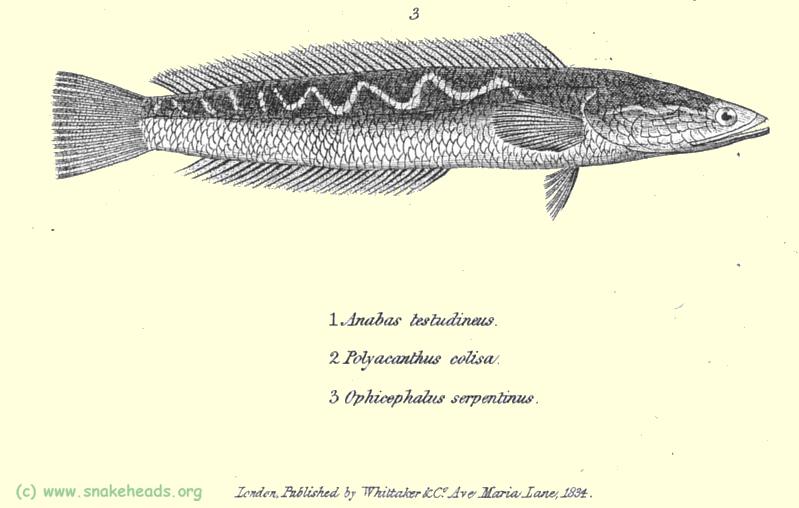
That is to say, that a part of the superior pharyngeals of these fishes is divided into small lam??x, more or less numerous, intercepting cells, in which water can remain, flow upon, and moisten the gills when the fish is on dry land. Thus these fishes are permitted to repair?? to land, and crawl to a very considerable distance from the rivulets?? or pools which constitute their ordinary habitation; a singular faculty not unknown to the ancients.This also induces the people of lndia to believe that these fishes fall from heaven.
[ ... ]
Resembles all the preceding genera in most of its characters, and particularly in the cellular conformation of the pharyngeals, which are adapted to retain water. These fishes also creep to a considerable distance from their liquid abodes, but what particularly distinguishes and even separates them from all acanthopterygii is the absence of spines in the fins, the first ray of their ventrals at most excepted, and even that, though simple, is not sharp and stiff. Their body is, elongated, and almost cylindrical; their muzzle short and obtuse; their head depressed, and furnished above with scales, or rather polygonal plates, as in anabas, &c. There are five rays in their branchiae: the dorsal occupies nearly their whole length; the anal is also very long, the caudal rounded, the pectorals and ventrals moderate, and the lateral line uninterrupted. Their stomach is shaped like an obtuse sac; two tolerably long coeca adhere to the pylorus; the abdominal cavity extends above the anal, close to the end of the tail. The jugglers of lndia exhibit this fish out of water, and even the children amuse themselves by forcing it to crawl upon the ground. In the markets of China the larger species are cut up alive to distribute to the buyers 1 . They may be divided by the number of their dorsal rays.
 | O. serpentinus, probably found by Finlayson in Siam. Today, O. serpentinus is considered a synonym for C. micropeltes. |
1 This is most incontestably the genus alluded to by Theophrastus. We doubt this because Theophrastus only reported on a fish going out of the water in India . [snakeheads.org] Back
2 Ophicephalus punctatus, Bl. or Oph. lata, Buchan . O. marginatus, Cuv. , or O. gachua, Buchan ? pl xxi. f. 21 , or Cora motta, Russell, ii. pl. clxiv , O. aurantiacus, Buchan . Back
3 Ophicephalus striatus, Bl. 359 , or Muttah, Russell, pl. clxii or O. chena, Buchan? O. sola, O. sowara, Russell, 163 . Back
4 Ophicephalus marulius, Buch. , which is the Bostrichoide oeillé, Lacép. II xiv. 3 . Oph. barca, Buch. xxxv. 20 , to which the Bostrichoide tacheté, Laceép. iii p. 143 , is at least very closely allied, and several new species to be described in our Ichthyology. Back
This passage was originally published in: The class Pisces arranged by the Baron Cuvier, with supplementary addtitions, by Edward Griffith and Lieut.-Col. Charles Hamilton Smith . London, 1834, pp. 217-222.
| © 2001 - 2004 snakeheads.org | HOME of this page |